Author: Arthur Cheong & Eugene Yap, DeFiance Capital; Translated by: 0xjs@黄金财经
The European Renaissance, which began in the 14th century, inspired a renaissance in art, culture, and thought that transformed modern civilization.
Today, we are witnessing a similar awakening in the cryptocurrency space - the decentralized finance (DeFi) renaissance. Like similar movements throughout history, this movement is breaking down barriers and reshaping the way we think about money and finance. Powered by blockchain and smart contracts, DeFi democratizes financial services, allowing people around the world to enter a trustless economy without traditional financial intermediaries. It has the potential to completely reshape finance.
Just as the European Renaissance thrived due to technological advances and social changes, the DeFi renaissance is driven by key factors that pull it out of its early challenges and into a new period of growth and innovation.
1. DeFi is emerging from the trough of disillusionment
DeFi surged in 2020 and 2021 as many believed it would revolutionize traditional finance (TradFi). However, like most new technologies, early hype led to disappointment when the underlying infrastructure proved to be imperfect, leading to a recession in 2022.
However, like any revolutionary movement, DeFi has become stronger, emerging from the "trough of disillusionment" and beginning to climb the slope of enlightenment. The Gartner Hype Cycle is an effective framework to illustrate this journey, with DeFi now showing signs of a revival.
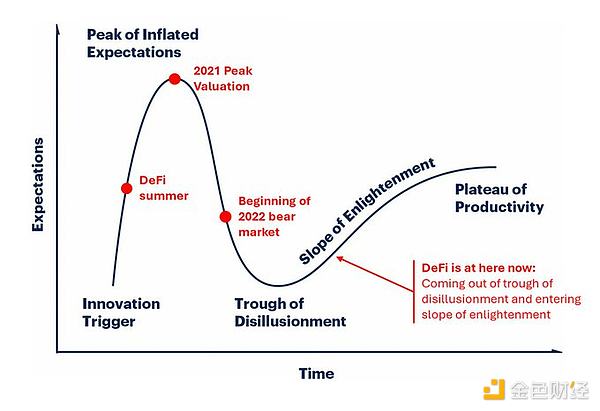 After two years of adjustment, key indicators such as total locked value (TVL) are rebounding, as shown in the figure below. While some indicators have improved due to rising crypto asset prices, transaction volume on DeFi platforms has also increased significantly, almost returning to 2022 levels, proving that the recovery is real.
After two years of adjustment, key indicators such as total locked value (TVL) are rebounding, as shown in the figure below. While some indicators have improved due to rising crypto asset prices, transaction volume on DeFi platforms has also increased significantly, almost returning to 2022 levels, proving that the recovery is real.
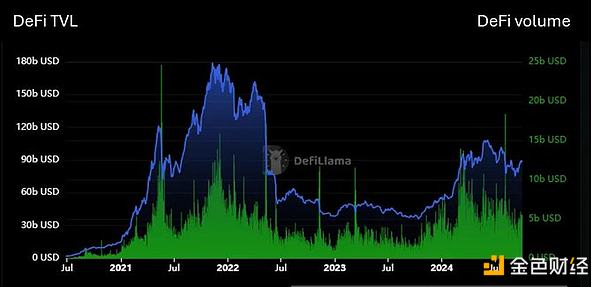 In fact, several indicators of some basic DeFi projects (such as Aave) have even exceeded their peaks in 2022. For example, Aave's quarterly revenue has exceeded that of the fourth quarter of 2021 (considered to be the peak of the last bull market).
In fact, several indicators of some basic DeFi projects (such as Aave) have even exceeded their peaks in 2022. For example, Aave's quarterly revenue has exceeded that of the fourth quarter of 2021 (considered to be the peak of the last bull market).
For our complete Aave analysis, see "Aave is seriously undervalued".
This shows that DeFi is maturing and entering a new stage of productivity, preparing for long-term scalability.
2. The new interest rate cycle will make DeFi returns more attractive
DeFi's recovery is not just driven by internal factors; external economic changes also play a key role. As global interest rates change, risk assets such as cryptocurrencies, including DeFi, become more attractive to investors seeking higher returns.
With the Federal Reserve implementing a 50 basis point rate cut in September, interest rates may be lower in the coming period, similar to the environment of the cryptocurrency bull market in 2017 and 2020, as shown in the figure below. Bitcoin (and cryptocurrency) bull markets are highlighted in green and have historically been in low interest rate regimes, while bear markets are highlighted in red, usually during periods of soaring interest rates.
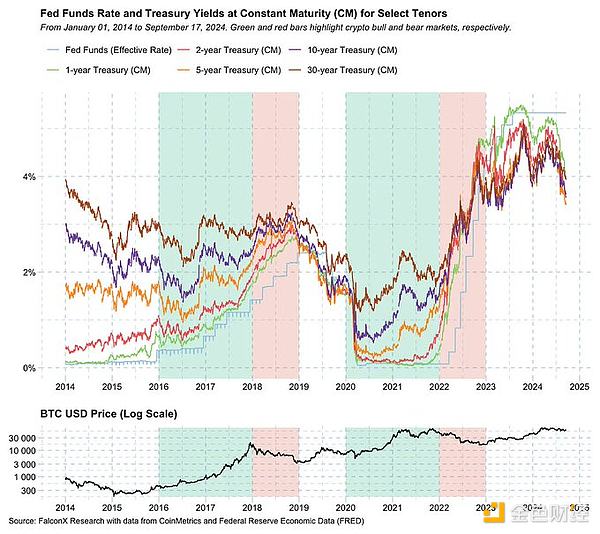
DeFi benefits from lower interest rates in two main ways:
1. Reduce the opportunity cost of capital - Due to lower interest rates, government bonds and traditional savings accounts offer lower returns, and investors may turn to DeFi protocols that offer higher returns, such as through yield farming, staking, and liquidity provision.
2. Cheaper loans--The cost of financing becomes lower, encouraging DeFi users to take out loans and use them for productive purposes, thereby driving overall activity across the ecosystem.
While interest rates may not drop to the near-zero levels of past cycles, the opportunity cost of participating in DeFi will be significantly reduced. Given that the difference between interest rates and returns can be amplified through leverage, even a modest drop in interest rates is enough to have a huge impact.
In addition, we expect the new interest rate cycle to be a major driver of stablecoin growth because it significantly reduces the cost of capital for traditional financial funds seeking returns to turn to DeFi.
In the previous cycle, the FFR (Federal Funds Rate) had an inverse relationship with the growth of stablecoin supply, as shown below. As interest rates fall again, the stablecoin supply is expected to grow, providing more funds for the acceleration of DeFi.
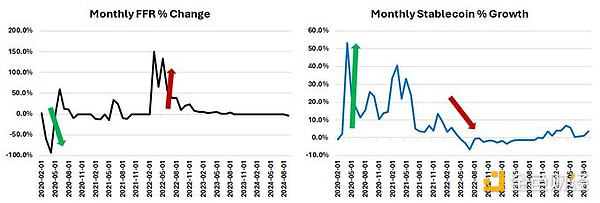
3. Finance: (Still) the Biggest Product-Market Fit for Cryptocurrency
The crypto space has tried various crypto use cases, such as NFT, metaverse, games, social, etc. However, according to most objective metrics, they have not really found product-market fit (PMF).
Consider the following scenario: Even if there is a brief recovery led by Bitcoin Ordinals in 2024, NFT daily transaction volume will continue to decline.
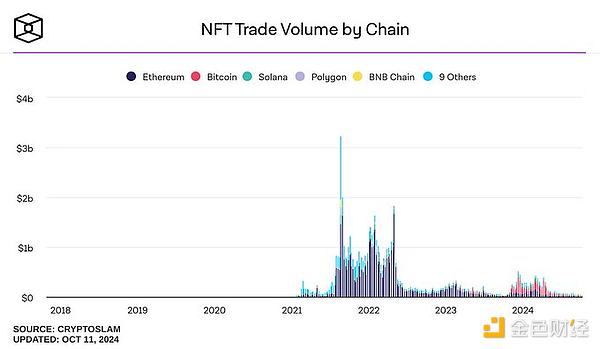
As for the metaverse and games, there are currently no breakthrough Web3 games that are loved by fans around the world. Two OG Web3 metaverses, Decentraland and The Sandbox, struggle to get even a few thousand daily active users, while Roblox has a whopping 80 million DAUs. TON Games’ DAUs are impressive, but it’s uncertain how many people will continue to play games on TON when there are no more economic incentives.
On the other hand, DeFi has proven its product-market fit. The growth of core DeFi categories like liquidity staking and lending (up over 100% year-over-year) demonstrates its appeal. Meanwhile, new categories worth billions of dollars, such as restaking (Eigenlayer) and base trading (Ethena), which had zero TVL a year ago, are emerging. This explosive growth demonstrates the composability and permissionless nature of DeFi, where new financial “Lego blocks” are stacked on top of each other to unlock new use cases.
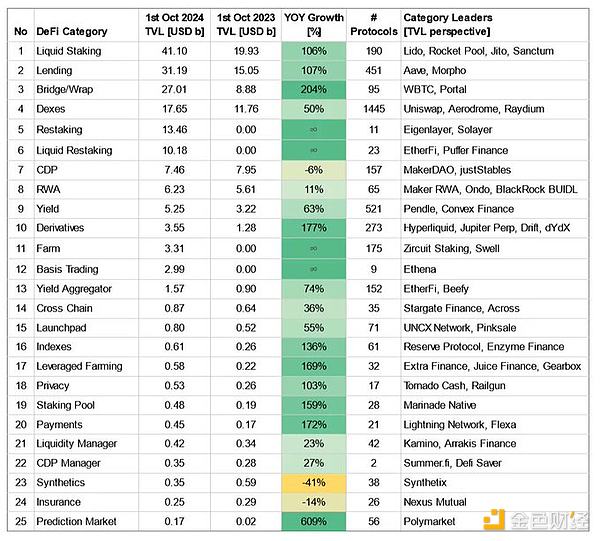
Regulatory barriers have long hindered DeFi's potential to disrupt TradFi, but DeFi's inherent advantages are clear. For example:
Cross-border transaction and remittance fees average 6%, and transfers take 3-5 business days.
Stock exchanges have bloated back-office systems and limited hours of operation, leading to inefficiencies.
Real-world assets, such as real estate, can benefit from tokenization, unlocking liquidity, and enabling composability in DeFi, such as for use as collateral.
DeFi is a more efficient alternative with its ability to operate 24/7, low cost, high liquidity, and no intermediaries. The technology already exists; the challenge is whether regulators will allow DeFi to disrupt a $10 trillion global financial industry that thrives on inefficiencies.
To illustrate how DeFi outperforms TradFi in terms of efficiency, let’s compare the cost of running a service in both systems. Here’s the breakdown based on an IMF study:
Labor costs: Labor costs in DeFi are close to 0%, while labor costs in TradFi are 2-3%. For example, DeFi loans are processed automatically without human intervention, while TradFi requires manual review and paperwork.
Operational Costs: DeFi has an operating cost of just 0.1%, compared to 2-4% for TradFi. DeFi avoids the need for large offices or intermediaries, as smart contracts process transactions and blockchain provides verification.
Overall, the marginal costs of traditional finance reach 6-8% in developed economies and 10-14% in emerging markets, and these costs are passed on to the end user.
DeFi eliminates these inefficiencies. It's that simple.
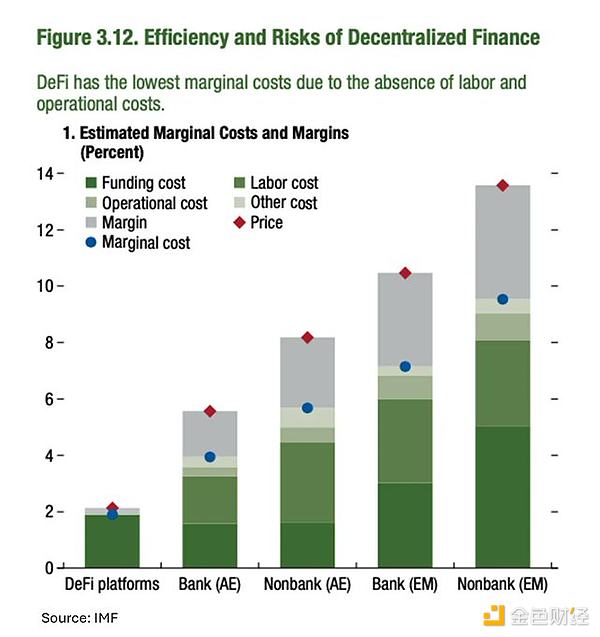 Furthermore, the financial technology (Fintech) sector has seen little innovation in the past 15 years, which echoes Blockchain Capital's research. While we have made great progress in areas such as artificial intelligence and global internet access, Fintech is still stuck in outdated systems, such as the 50-year-old SWIFT system used by all banks, and transfers typically take 1-4 business days.
Furthermore, the financial technology (Fintech) sector has seen little innovation in the past 15 years, which echoes Blockchain Capital's research. While we have made great progress in areas such as artificial intelligence and global internet access, Fintech is still stuck in outdated systems, such as the 50-year-old SWIFT system used by all banks, and transfers typically take 1-4 business days.
Most Fintech advances, such as digital payments, fractional shares, and APIs, are focused on improving the user experience rather than addressing the core inefficiencies of traditional finance. For example, Robinhood and Plaid have built easy solutions for everyone to buy stocks, but they still rely on old financial infrastructure. The real problem is that fintech connects to outdated systems to make the best of them, rather than creating something entirely new. While these changes are helpful, they don’t solve the deeper problems that plague the traditional financial world.
DeFi is different. It’s digital from the start. Instead of operating around the old financial system, DeFi embeds financial services directly into the internet.In DeFi, things like fractional shares, overcollateralized loans, and global payments aren’t innovations — they’re just basic features. This marks a fundamental shift in the way finance works, from small improvements to radical overhauls.
By adopting DeFi, we can move beyond small tweaks and start unlocking a host of new economic opportunities, improving access to financial services, and creating wealth in places that TradFi often overlooks. It’s about reinventing the financial system to work better in a digital world.
Looking ahead, the 2024 U.S. election could bring clarity on regulation. A Trump presidency could bring crypto-friendly regulations, while a Harris administration, which has recently changed its tune on the industry, is likely to maintain a positive stance. Regardless of the political outcome, the momentum behind DeFi is undeniable.
DeFi is just getting started, and the future of finance is decentralized and on-chain.
4. Enhanced UI/UX, infrastructure, and security
DeFi's early shortcomings were clunky interfaces and technical complexity, which led to user churn. However, user experience, infrastructure, and security have improved significantly over the past few years, making DeFi more accessible to mainstream users.
One of the most notable improvements is in wallet infrastructure. Managing mnemonics and private keys used to be a major hurdle, but new smart wallets and embedded wallets make the process simpler and more secure. Features like social recovery, biometric authentication, and passwordless login now make it easier for users to manage funds without the complexity of traditional Web3 wallets.
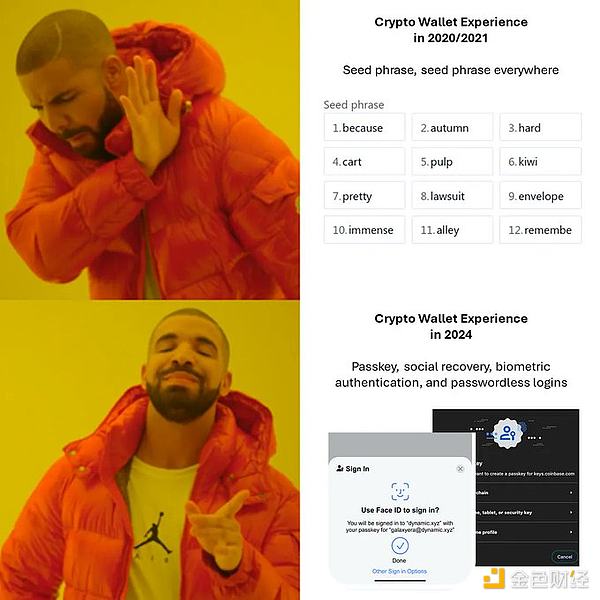
Security has also improved, with more thorough smart contract audits before deployment becoming standard. Platforms such as ImmuneFi encourage white hat hackers to discover vulnerabilities and security issues through bug bounty programs, ensuring that vulnerabilities are addressed before they are exploited. These developments in wallet infrastructure and security make DeFi safer and more efficient for all users. This result is reflected in the sharp decline in the number of DeFi hacks over the past year.
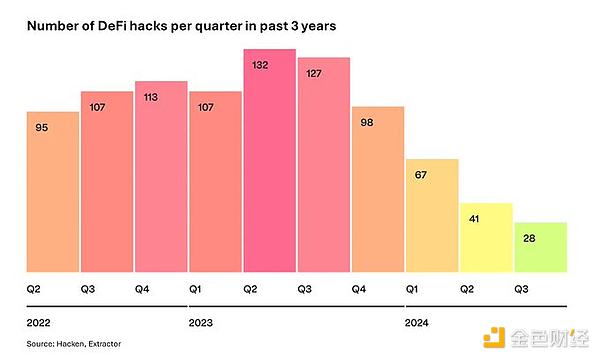 With these improvements, DeFi is becoming more and more accessible to the mainstream, including institutional adoption, driving its continued growth.
With these improvements, DeFi is becoming more and more accessible to the mainstream, including institutional adoption, driving its continued growth.
Make DeFi Great Again
Just as the European Renaissance reshaped society, DeFi will revolutionize finance. The potential for innovation in DeFi is huge, and we are just beginning to see its impact. As more users and investors embrace DeFi, the future of global finance will increasingly move on-chain, making the financial system more efficient, open, and accessible to everyone.
DeFi has the power to eliminate inefficiencies, break down barriers, and create new opportunities for financial inclusion. This is not just a short-lived trend, but a fundamental shift in the way the world interacts with money. From global payments to the democratization of financial services, DeFi offers a future where anyone can participate in the financial system.
Currently, the total market capitalization of all DeFi protocols is approximately $33 billion, which accounts for only about 1.4% of the total cryptocurrency market capitalization of $2.3 trillion.
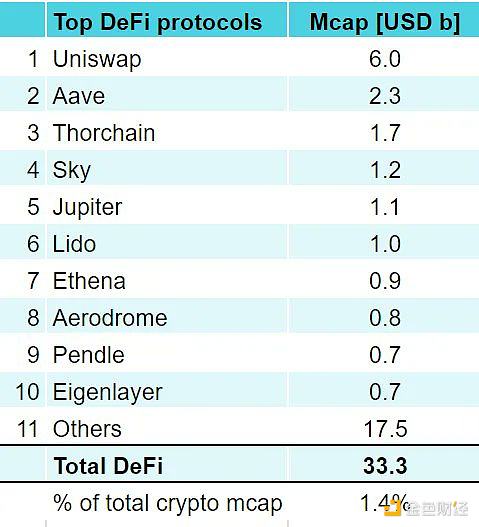
Data as of October 13, 2024
Given the severity of market conditions and industry environment, the growth and success of DeFi has been largely overlooked recently. However, this situation will change when DeFi protocols continue to grow at an astonishing rate and return this growing value to token holders, such as Aave As it did in its recent token economics change proposal. Market participants will further recognize the fundamentals and potential of DeFi and reallocate their capital accordingly.
As DeFi continues to grow and the market awakens to its latest appeal and new potential, we expect such DeFi assets to grow from 1.4% to 10% of the total cryptocurrency market capitalization in the next 2 years.
Make DeFi great again.
Acknowledgements
1. Popularizer of the term "DeFi Renaissance"
2. DeFi's strong comeback
 JinseFinance
JinseFinance

 After two years of adjustment, key indicators such as total locked value (TVL) are rebounding, as shown in the figure below. While some indicators have improved due to rising crypto asset prices,
After two years of adjustment, key indicators such as total locked value (TVL) are rebounding, as shown in the figure below. While some indicators have improved due to rising crypto asset prices,  In fact, several indicators of some basic DeFi projects (such as Aave) have even exceeded their peaks in 2022. For example, Aave's quarterly revenue has exceeded that of the fourth quarter of 2021 (considered to be the peak of the last bull market).
In fact, several indicators of some basic DeFi projects (such as Aave) have even exceeded their peaks in 2022. For example, Aave's quarterly revenue has exceeded that of the fourth quarter of 2021 (considered to be the peak of the last bull market). 



 Furthermore, the financial technology (Fintech) sector has seen little innovation in the past 15 years, which echoes Blockchain Capital's research. While we have made great progress in areas such as artificial intelligence and global internet access, Fintech is still stuck in outdated systems, such as the 50-year-old SWIFT system used by all banks, and transfers typically take 1-4 business days.
Furthermore, the financial technology (Fintech) sector has seen little innovation in the past 15 years, which echoes Blockchain Capital's research. While we have made great progress in areas such as artificial intelligence and global internet access, Fintech is still stuck in outdated systems, such as the 50-year-old SWIFT system used by all banks, and transfers typically take 1-4 business days. 
 With these improvements, DeFi is becoming more and more accessible to the mainstream, including institutional adoption, driving its continued growth.
With these improvements, DeFi is becoming more and more accessible to the mainstream, including institutional adoption, driving its continued growth. 





